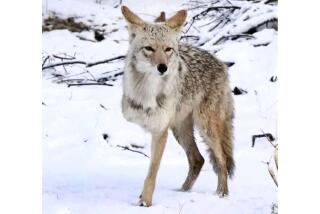Ancient beasts roamed this secret spot in Death Valley, but you probably can’t go
Paleontologists call it “The Barnyard,” a remote box canyon in an inhospitable desert where slabs of mud stone as big as billboards are indented with fossil tracks left by mastodons, camels, horses and cats the size of leopards.
It is one of the largest, most diverse and well-preserved deposits of prehistoric mammal and bird tracks known to exist, and a window onto the ecology of Death Valley during the Pliocene Epoch, about 5 million years ago, when things were starting to heat up.
“I tell every person I take into the canyon that ... it could easily be destroyed before they get another chance to see it.
— Birgitta Jansen, naturalist
The prints tell stories, frozen in stone, of an adult camel with a newborn following close behind; of a horse slipping in soggy ground and landing on its backside; of mastodon herds following the scent of water before climate change and tectonic forces transformed the region into the hottest, driest place on Earth.
Between the footprints of mega-fauna are the thread-thin lines of bird tracks, and fossilized shoreline features including ripples and raindrop impressions.
“This canyon is as good as it gets — there are fossil tracks almost everywhere you look,” said Torrey Nyborg, a Loma Linda University paleontologist who this month completed the first inventory of the tracks, and is helping the National Park Service devise formal plans to protect and manage them.
Formal protections have been a long time coming for the canyon, which the park service has hidden from public view since 1940, fearing that information about it would invite theft or destruction by vandals and visiting hordes.
Even now, officials ask that the exact location not be divulged in news stories and require visitors to get a permit and be accompanied by a federal ranger or designated naturalist.
To reach the canyon on Sunday, Nyborg, naturalist Birgitta Jansen and park ranger Abby Wines tramped up a 3 1/2-mile-long trail, following a path through a labyrinth of sheer-walled canyons where the temperature can soar above 120 degrees.
Rounding one last turn, Jansen smiled and said, “We’ve arrived. Welcome to The Barnyard.”
The profusion of tracks range from about 1 to 15 inches in length. Paleontologists have matched them with mastodons, one species of tapir, 12 species of birds, five species of cats, five species of camels and three species of horse.
Their prints were not created simultaneously. They were made in successive layers of mud that settled along the shores of a spring-fed lake that was a magnet for generations of migrating mammals and birds.
“The springs dried up after tectonic activity began pushing the landscape upward,” Nyborg said. “The tracks changed into mud stone. Over time, layers of mud stone were folded and uplifted by tectonic forces, exposing the arrays of fossil tracks we see today.”
Using high-definition cameras and GPS coordinates, it took Nyborg four years to inventory the tracks spread across five square miles of rugged terrain. Erosion and landslides destroy countless tracks each year — and expose new ones, he said.
In some cases, thieves have used chisels to hack off and cart away fossil tracks that took eons to form. The incidents are among many examples of vandalism in the 5,270-square-mile national park visited by more than 1 million people each year from around the world.
The park service permits only about 100 people a year to enter the canyon. Nyborg would like to change that.
“This canyon has been in the dark too long; I want to see it unveiled to the world,” he said. “Its survival may ultimately depend upon strong public support for new management plans to protect it.”
Spencer Lucas, a paleontologist at the New Mexico Museum of Natural History and Science, agrees.
“Sensitive, important places like this,” he said, “present both management challenges and educational opportunities that fall within the National Park Service’s mandate to conserve natural wonders and interpret them on behalf of public taxpayers.”
“But striking the right balance is a tricky business for federal land agencies,” he added, “who are pressed to make tough decisions about where to spend their limited funds.”
Even respectful hikers can destroy the fragile tracks of prehistoric shorebirds imprinted on sheets of mud stone as thin as paper.
“I tell every person I take into the canyon,” Jansen said, “that it deserves their total attention because it could easily be destroyed before they get another chance to see it.”
“And even before we hit the trail,” she added, “I make them promise not to reveal its name or location.”
ALSO
Earliest-known Ten Commandments tablet sells for $850,000 at Beverly Hills auction
Santa Ana winds bring fire risk, frost advisories to Los Angeles and Ventura counties
Friends and family seek answers after Los Angeles couple vanishes during desert camping trip
More to Read
Start your day right
Sign up for Essential California for news, features and recommendations from the L.A. Times and beyond in your inbox six days a week.
You may occasionally receive promotional content from the Los Angeles Times.







